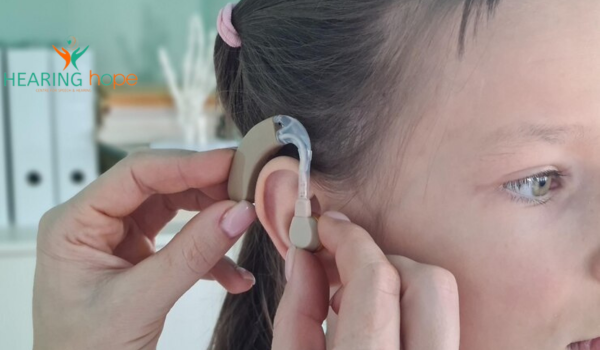
How to Put in Hearing Aids: A Complete Guide
Correctly inserting hearing aids is essential for comfort and optimal hearing performance. If you’re wondering how to put hearing aids into your ear canal, this guide will walk you through the process with helpful tips. Correct hearing aid insertion ensures that the device works effectively, preventing discomfort and potential damage to both the hearing aid and your ear.
The process may seem tricky at first, but with practice and proper guidance, inserting your hearing aid will become easy and natural. From aligning the hearing aid correctly to ensuring a secure fit, we’ll cover everything you need to know. Understanding the different types of hearing aids, such as Behind-the-Ear (BTE) and In-the-Ear (ITE), will also help you insert your device properly.
Whether you’re new to hearing aids or just need a refresher, this article will provide the necessary steps to help you insert your hearing aid with ease and confidence.
Step-by-Step Guide on How to Put in Hearing Aids
Step 1: Prepare the Device
- Make sure the hearing aid is clean.
- Check that it’s fully charged or has fresh batteries.
Step 2: Hold It Correctly
- Hold the aid so the part that goes into your ear faces the right direction.
- If it has a tube, let it follow the natural curve of your ear.
Step 3: Insert the Hearing Aid
- BTE (Behind-the-Ear): Place the device behind your ear and gently insert the tube or tip into your ear canal.
- ITE/ITC (In-the-Ear/In-the-Canal): Gently insert the molded aid into your ear canal.
Step 4: Adjust the Fit
- Press lightly to ensure it’s comfortable and secure.
- It shouldn’t feel too tight or cause pain.
Step 5: Final Check
- Confirm that the device is working.
Looking for the best hearing aid in India? Choosing the right device makes insertion and daily use much easier—consult an audiologist for the best match based on your hearing needs.
Understanding Hearing Aids
Before diving into the actual process, let’s first understand what hearing aids are and why the correct insertion is important.
What Are Hearing Aids?
Hearing aids are small electronic devices that amplify sound for people with hearing loss. These devices are designed to help individuals with varying degrees of hearing loss—from mild to profound—by improving the clarity of sounds and speech.
Why Proper Insertion Matters
Correct insertion of hearing aids ensures the device works effectively, providing the best sound quality. Improper insertion may lead to discomfort, feedback noise, and reduced functionality, affecting your overall hearing experience.
Common Problems: Difficulty Inserting Hearing Aids
For some people, inserting hearing aids may feel challenging, especially if they have never used them before. Here are a few common difficulties and how to overcome them:
Reasons for Difficulty
- Deficit issues: Some individuals may have difficulty handling small devices, especially those with arthritis or other mobility challenges.
- Improper fit: If the hearing aid isn’t properly molded to the ear, it might not fit well.
- Earwax buildup: Excess earwax can prevent the hearing aid from sitting properly in the ear.
How to Overcome These Challenges
- Use a mirror: Position yourself in front of a mirror to ensure the hearing aid is placed correctly.
- Consult a professional: If you’re having trouble with fit or insertion, visiting an audiologist can provide a custom solution.
- Earwax removal: Keep your ear canal clean and free of wax to ensure a snug fit.
When to Seek Professional Help
If you are still facing difficulty inserting your hearing aids, it’s best to consult an audiologist. They can provide personalised adjustments and tips to make the process easier. If the issue continues, it could be related to hearing aid problems such as poor fit, feedback, or device malfunction—getting expert help can ensure everything works properly and comfortably.
Hearing Aid Types and Their Insertion Methods
Different types of hearing aids come with different ways to insert them. Knowing how to use them properly ensures comfort and better sound.
Behind-the-Ear (BTE)
- Use: For moderate to severe hearing loss
- Insert: Place the device behind the ear and gently fit the tubing or earmold into the ear canal.
In-the-Ear (ITE)
- Use: For moderate to severe hearing loss
- Insert: Insert the custom-molded aid into the ear canal until it fits snugly.
In-the-Canal (ITC) & Completely-in-Canal (CIC)
- Use: For mild to moderate hearing loss
- Insert: Gently place the small device inside the ear canal; adjust it for comfort.
Receiver-in-the-Canal (RIC)
- Use: For a more natural sound and discreet look
- Insert: Place the receiver in the ear canal and position the rest of the device behind the ear.
Also read: Top 10 hearing aid brands in India
The Role of an Audiologist in Fitting Hearing Aids
While it’s helpful to understand the general process of inserting hearing aids, it’s important to consult with an audiologist, who plays a critical role in ensuring the device fits correctly and performs at its best. Here’s how an audiologist can assist:
- Initial Consultation and Assessment: An audiologist will begin by performing a thorough hearing evaluation to determine the degree and types of hearing loss. This will guide them in recommending the most suitable hearing aid for your needs.
- Custom Fitting: An audiologist can customize hearing aids to fit your ears perfectly. Custom-molded devices are often necessary to ensure comfort and optimal sound quality. They’ll take precise moulds of your ear, which are then used to create a hearing aid that fits comfortably.
- Adjustments and Fine-Tuning: During your initial fitting, the audiologist will help adjust the device for maximum performance. They’ll test the hearing aid, check for sound clarity and comfort, and make fine adjustments as needed.
- Ongoing Support: Audiologists provide ongoing support, making adjustments as your hearing needs change over time. They can help if you have trouble inserting the hearing aid or experience any discomfort.
Read also: Signia Hearing Aids Price in India to explore cost-effective options and find the right model for your hearing needs.
Hearing Aid Accessories and Tools to Help with Insertion
In addition to the hearing aids themselves, several accessories can help you with the insertion process. These accessories make the task easier and ensure that the hearing aid fits securely and comfortably.
- Hearing Aid Inserts and Wax Guards: Some hearing aids come with specialized ear inserts or wax guards that help keep the hearing aid clean and free from earwax buildup. These accessories can also help with easy insertion and ensure a proper fit in the ear canal.
- Hearing Aid Removal Tools: Sometimes, hearing aids can be difficult to remove. Tools designed specifically for removing hearing aids make the task easier without damaging the device or causing discomfort.
- Ear Molds and Custom Tips: Custom ear moulds and tips help to ensure that the hearing aid fits snugly inside the ear canal. For people with unique ear shapes, custom ear moulds provide a more comfortable and secure fit.
- Drying and Cleaning Tools: Regular cleaning is essential for comfort and performance. Drying kits and cleaning tools help remove moisture and dirt, which is an important part of good hearing aid care and maintenance.
Conclusion
Inserting a hearing aid correctly is essential for getting the best performance and comfort. By following the steps outlined in this guide on how to insert hearing aids, you can make the process easier and more efficient. If you encounter any issues or feel uncomfortable, don’t hesitate to reach out to a hearing aid center in Delhi or consult a hearing care professional who can assist you in achieving the best fit for your hearing aid. This ensures not only optimal functionality but also comfort throughout the day.
Frequently Asked Questions
To set up a hearing aid:
Insert the battery (or fully charge it if it’s rechargeable).
Turn it on by closing the battery door or pressing the power button.
Place it in your ear (for in-ear models) or behind your ear (for BTE models), following the user manual.
Run the initial fitting – usually done by your audiologist or using the manufacturer’s app.
Adjust volume and programs using the onboard buttons, remote, or app.
Check for feedback (whistling sounds) and reposition if needed.
If unsure, ask your audiologist for a demo or adjustment session.
To use your hearing aid correctly:
Wear it daily so you get used to the sounds.
Keep it clean and dry — wipe it with a soft cloth and avoid moisture.
Insert and remove it carefully as instructed.
Adjust volume or settings as needed for different environments.
Replace or recharge batteries regularly.
Attend follow-ups with your audiologist for fine-tuning.
Yes! Here’s a simple trick:
For behind-the-ear (BTE) models: Hook the device over your ear first, then gently insert the earmold or dome into your ear canal.
For in-the-ear (ITE) or completely-in-canal (CIC) models: Hold the device between your thumb and forefinger, align it with your ear canal, and gently push it in using a slight twisting motion.
Tip: Use a mirror until you get the hang of it.
You can set your hearing aids by:
Selecting the right program or mode for your environment (quiet, noisy, music, etc.).
Adjusting volume manually or through the app/remote.
Using the manufacturer’s app to fine-tune settings like treble, bass, or noise reduction.
Saving preferred settings if your device allows.
If you’re unsure, your audiologist can help program and personalize them for you.
The easiest way is:
Sit or stand in front of a mirror.
Hold the device properly (check left vs. right — they’re often color-marked: red for right, blue for left).
Gently place it in or over your ear:
For BTE: hook over ear, then insert earpiece.
For ITE/CIC: align with canal, gently push in.
Do not force — if it doesn’t go in smoothly, reposition and try again.
With practice, it becomes quick and natural.
Dr. Harshi, is an accomplished Audiologist with extensive expertise in treating individuals with hearing impairments.

